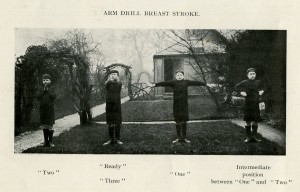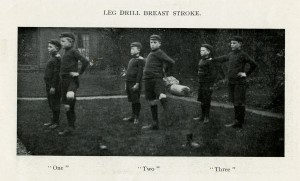One of my favourite documents in our collection is about swimming. Within the records of the children’s homes that were run by The Children’s Society, there are a number of documents that mention physical exercise. This suggests that exercise was something that the children in the homes were encouraged to participate in.
The boys living at St Mark’s Home for Boys in Natland, Cumbria, in the early-20th Century were known for swimming, and a number of boys from the home had been awarded swimming certificates by the Royal Life Saving Society.
The secret of St Mark’s Home’s swimming success was down to the way the boys were taught to swim. In fact, their method was seen as so effective that the home published a manual for other swimming instructors to learn from.
St Mark’s Home was three miles away from the local swimming pool, which meant that they weren’t able to use the pool very often. Instead, they decided on a method of teaching that may seem unusual to us now. The swimming manual states:
The method now adopted is to instruct and drill our beginners in class on land until they are at home with every position and movement for breast stroke, and the positions for floating and diving; at least a dozen drills, occupying a quarter of an hour each drill, are necessary before taking the class to the baths at all.
Helpfully, the manual comes with photographs of the boys doing their land drills for different swimming strokes, showing the positions they needed to learn and the numbers they had to call out while doing the drills.
For the boys at St Mark’s Home, this method of teaching seemed to work very well. I can’t help but wonder, though, if it wasn’t the method itself but instead the attitude of the instructors that helped the most. As the manual says:
Confidence is all-important to the learner, so no ducking is allowed, and we think the method of teaching by throwing a water-shy boy or any other boy into deep water is the last effort that should be resorted to.
Lying beneath these words is a hint at how other instructors were teaching children to swim at the time. I don’t know about you, but I certainly know which method I’d prefer!



Swimming was so integral in those days, it seems, with nude batheing common in urban lidos and rivers. Some childrens’ homes weren’t averse to a Victorian or Edwardian period exceptance of communal (male) nudity in swimming despite – at the same period’s aversion to bare lady’s and table legs having to be purposefully covered in lengthy pretty damask weavery. I was in care at Hutton Poplars Residential School (since closed as a village style institution and demolished) in the late 1940’s as a 4/5 year old. An abiding memory is nude being hooked by my little hands onto the inner tiled rim grab of the Hutton Poplars swimming pool where I with others grabbed and edged, unable to swim, our way around the inside of the pool. I fell off the slippery side and clearly recall sitting on the bottom of the pool with water above me feeling no at all perturbed. I don’t remember how I was rescued. I haven’t learned to swim.
Dear Bobbie,
Thanks for sharing that memory with us.
We do have records of children in other homes bathing in local rivers, so it would be interesting to learn how they were taught to swim, and if it was similar at all to the Natland method.
Regards,
Janine
St Marks Children’s Home is now called Appletree (established 1995). We still help care for and educate young boys and girls. Swimming is also still very important! We arrange for individual private lessons to help each child develop this vital life skill. It also builds their self esteem and overall confidence. The children’s pride in their achievements was evident as Swimming Certificates were presented to them as part of our Annual Awards Ceremony in July this year. Whereas previously children would stay in the home throughout their childhood, we now re-integrate over 90% of our leavers to families and day schools. Many former residents of St Marks Home and Appletree stay in touch and we welcome their contact and involvement.
Dear Clair,
Thanks for the information about Appletree. It’s really great to hear about the continuity of the home still looking after children, and still teaching them to swim after all these years! It’s fascinating to see the past and the present match up like this.
Regards,
Janine